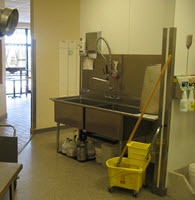By Jeff Pence, contributing writer
We in the camping and conference center industry have always been a profession known for getting the job done even in the face of conflict and adversity. We see what our options are, make the best choice available, and keep moving on. We are the masters of duct tape and bailing wire to keep our operations working, but we do need to take a realistic look at the life expectancy and replacement of kitchen equipment.
There are two sides to every story, and kitchen equipment is no exception. A camp under construction or undergoing a major remodeling may have the luxury of buying all new equipment to stock a well-designed kitchen, but not everyone gets that option. Following is a discussion about having new equipment and used equipment.
Buying New. You get the advantages of a warranty, manufacture package deals, and the latest and greatest technology, plus you get the longest product life available.
Another option is to buy nearly new equipment. A sad statistic today is that over half of all new restaurant ventures across this land fail in the first three years of operations. So there is a constant flow of repossessed or liquidation sales of equipment 1 to 3 years old. Typically equipment auctions sell this equipment at 10-20 cents on the dollar of the new purchase price.
However, if you don’t want to deal with the process and time of auctions, there are many great restaurant equipment resellers typically selling major equipment at 50% off the new price. Given that new equipment today has a life expectancy of 5 to15 years, it is a great value to look at this avenue.
Living with used and hand-me-down equipment. In the kitchen, we joke that old equipment never dies, it just gets donated to someone who needs it more that we do. No matter where (or when) you bought your current equipment, someday you will have to replace it. Often older equipment will run into difficulties with replacement parts, and older equipment has a higher probability for breaking down. With these facts in mind, always have a Plan B if equipment breaks down (stove top cooking, campfire cookouts, or pizza delivery). This is not to say that older equipment is bad, but if you do your own repairs, it is wise to stay stocked with some of the basic repair parts. By keeping a couple of thermal couples or toggle switches on hand, you can save a lot of drama during the peak season.
I have worked in many great kitchens that have 25 to 30-year-old used mixers, grills, and ovens, but again everything must have an end and progress has its cost. The bad news in replacing equipment is that the new replacement equipment won’t last nearly as long as what may be in your kitchen now. The good news is that the new equipment cost less today than many of the pieces they will replace, and they are typically much more efficient to operate.
Plan ahead, prepare ahead. Take a look at your kitchen and see where it stands. People don’t want to spend money if they don’t have to, but it is much cheaper to replace dying equipment during the off season. At that time you can shop and negotiate the best deals for your camp or center. The least desirable way to try and replace a key piece of equipment is during the heat of the season because “you need it now.”
Keep in mind also that not all equipment will fit into the same replacement schedule. Heating and holding equipment tend to last a lot longer than ice makers and upright coolers. A range, mixer, or oven may require a new thermal couple, switch, or gas valve, but as a whole, this kind of equipment lasts a long time and has a lower cost of maintenance than other pieces of equipment. Ice machines, cold boxes, and equipment with a lot of electronics tend to have the shortest life cycle and the highest repair costs.
At least one advantage to replacing old equipment is that the newer models tend to be more efficient and cost less to operate than their predecessors of 20 years ago. You will have to spend a little money on the upgrades, but hopefully you will see a reduction in utility costs and an increase in efficiency of your kitchen (not to mention your kitchen staff will love you :-)).
No matter where you are in the life cycle of your kitchen equipment, keep things running smoothly by having a replacement plan. You may get lucky and have equipment last for a life time, but good planning is like insurance. “It is better to have it and not need it, than need it and not have it.”
Jeff Pence serves as operations manager at Signature Services and can be reached at jeffp@signatureservices.com .

